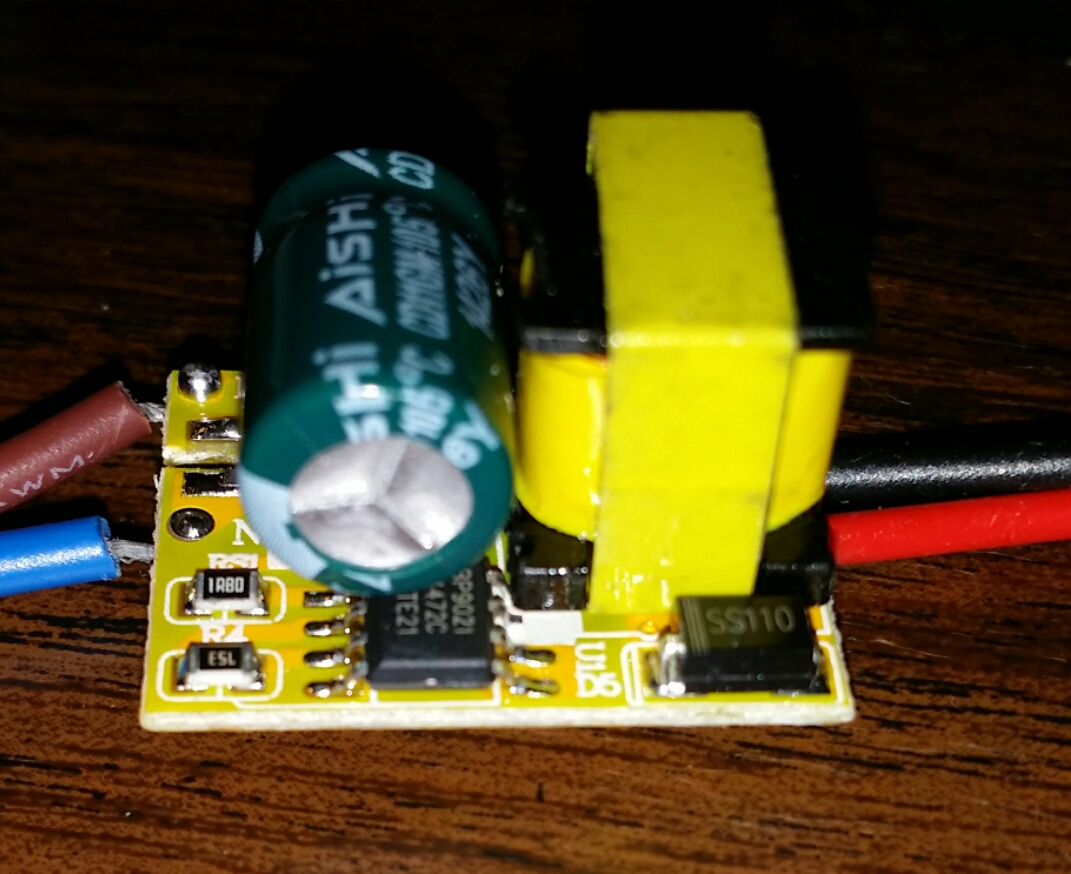LED Light is getting very hot
-
Hi All,
This isn't directly related to MySensors but I'm hoping there is someone out there with hardware experience who can offer some suggestions. I recently installed a LED light using Bruce's awesome dimmable sketch and I'm having a problem with the light getting VERY hot. So hot that it is desoldering the wiring connections and shorting the wires. Here is how I have things configured currently:
I have this light: http://www.ebay.com/itm/121350304951?_trksid=p2059210.m2749.l2649&ssPageName=STRK%3AMEBIDX%3AIT plugged into a 12v power supply. I am bypassing their included AC to DC converter because 1) it doesn't look super safe and 2) I already have 12v running to the location I want to use it. I don't have anything special connected to the 12v supply. It's just wired right to the red and black wires on the LED light.
Here is a (bad) picture of their converter:

So, does anyone out there know why it's getting so hot? Am I doing something wrong? Do I need to put some resistors in there? Or, is it just a bad quality light?
Thanks,
Pete
-
@petewill so, to make sure I understand you, you just connected the led light to 12v supply an completely removed the 12v supply that came with it (the picture included)?
Did you include any current limiting resistor in the 12v supply?
-
I agree with @Yveaux - the AC-DC power supply board may have also included current limiting. For 3W, that might be an active current limiter, but should be at least a resistor with sufficient dissipation. It sounds as if you might not have handled that function of the board.
-
Correct, I didn't limit it at all. I originally (admittedly not very intelligently) thought the converter was just going from AC to DC but it must have some additional functionality.
Any ideas what I should do? I have some 1/2 watt resistors but those would be too small right? Any idea what value and what wattage?
-
@petewill connect the DC supply that came with it and measure the current through the led when switched on.
Better get a dedicated led supply with this current rating then, because just dissipating using resistors isn't really the way you want to go...
-
I did the same thing, You must use a led-driver, And not use a real 12V power supply
-
Thanks everyone. I'll look into getting an LED driver. I just looked at the converter and it says the output is 320 mA so I'll look at getting one with that power rating. I think I'll also attempt to measure the current just to see what it's actually drawing.
Ok, so next question. Can I still use pulse width modulation (Bruce's sketch) with the driver or will it just be on/off?
Edit: Maybe this would work?
http://www.ebay.com/itm/12V-DC-AC-3x1W-High-Power-LED-Driver-Power-Supply-Pin-Connector-for-three-1W-New-/390894327199?pt=LH_DefaultDomain_0&hash=item5b031e159f
-
@petewill The 3x1W driver, judging from the picture, will just rectify the input (4 diodes) and limit current by 4 resistors.
Why don't you just ask @blacey what he used for his sketch?
-
@Yveaux Ok, thanks. I'll continue to do some more research. I believe @blacey only used the LED light strips. I have a few of those working without any issues, it's just the 3W puck lights that are giving me problems.
-
@petewill I have used the following successfully with the Dimmable LED Actuator.
http://www.amazon.com/gp/product/B004BYXUOO/ref=oh_aui_search_detailpage?ie=UTF8&psc=1
http://www.amazon.com/gp/product/B004BLKZ8Q/ref=oh_aui_search_detailpage?ie=UTF8&psc=1
http://www.amazon.com/gp/product/B004BCVM4Q/ref=oh_aui_search_detailpage?ie=UTF8&psc=1
If you are using multiple pucks, do you have them wired in series or parallel?
-
@blacey Thanks! I only have one wired in my basement as a test. What power supply are you using (how many amps)? I'm wondering if my supply is too powerful? It's a modified computer power supply so it has the ability to deliver 20 or so amps. I thought I remember reading somewhere that LEDs (diodes) will keep drawing more and more power unless they are limited in some way (resistor).
Maybe I should just attach my LED light to the converter that came with it and see how it behaves. Maybe it's just a bad design.
All this stuff is new to me so I need to keep learning.
-
@petewill Yes, I would test various configurations as a process of elimination. For example, does the light still get hot if you simply connect the LED to the Power Supply? If so, then it has nothing to do with the PWM circuit.
That said, 20 AMPs is too much if the LED actually draws that much. While your power supply can supply up to 20 AMPs, it will only do so if the load demands it.
I use different supplies depending upon the anticipated load for a given install. For example, I like this supply http://www.amazon.com/gp/product/B0034GUEY4/ref=oh_aui_search_detailpage?ie=UTF8&psc=1.
I personally try to match the supply capacity to the LEDs by computing the power needed for the install and go with the lowest power supply needed.
-
Just got some parts and did some more testing on this so I thought I'd post a reply.
The good news is there appears to be a cheap fix. As @Hoffan suggested I did some research on LED drivers. I found this one to work in my testing so far: http://www.ebay.com/itm/181113937482. I have plugged it in directly to the 12V source for 3 hours and it gets warm (maybe 100 degrees Fahrenheit) but by no means hot.
I still need to connect it into my sensor and get it working with PWM. My plan is to limit the current before the MOSFET. I hope it works!
Thanks again for all the help and suggestions!